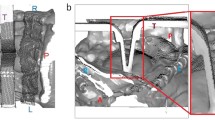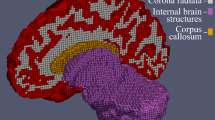Abstract
In neurosurgery, brain retraction technique has become popular in the field of image-guided procedures for intracranial operations such as in brain tumor, cerebral aneurysms, cerebral hematoma, etc. Brain retraction is performed for adequate exposure during surgeries as such procedures require consistent retraction. This causes several local brain contusions which limit the accuracy of the image-guided neurosurgical system. Therefore, there is a need for training in this field to enhance the efficiency of the procedure. In this study, we present a 3D finite element brain model, segmented from human head magnetic resonance images, in the visco-hyperelastic framework. The numerical model is used to predict the deformation and stress fields within the brain during brain retraction. The brain was retracted by 5 mm and retained at that position for 30 min. It was observed that during this period, the retraction pressure decreased to 30% of the maximum pressure level generated due to interhemispheric retraction. The results show that brain retraction can be performed continuously up to 30 min without any risk of local brain contusions or postoperative complications. Finally, through a combination of judicious retraction and rigorous preoperative planning, a drop in the morbidity rate due to brain retraction is expected in the future. This technique can be used for preoperative effective planning and training, especially in minimally invasive brain surgeries.
Access this chapter
Tax calculation will be finalised at checkout
Purchases are for personal use only
Similar content being viewed by others
References
Zhong, J., Dujovny, M., Perlin, A.R., Perez-Arjona, E., Park, H.K., Diaz, F.G.: Brain retraction injury. Neurol. Res. 25(8), 831–838 (2003). https://doi.org/10.1179/016164103771953925
Sase, K., Fukuhara, A., Tsujita, T., Konno, A.: GPU-accelerated surgery simulation for opening a brain fissure. Robomech. J. 2(1), 17 (2015). https://doi.org/10.1186/s40648-015-0040-0
Li, P., Wang, W., Zhang, C., An, Y., Song, Z.: In vivo investigation of the effectiveness of a hyper-viscoelastic model in simulating brain retraction. Scienti. Rep. 6, 28654 (2016). https://doi.org/10.1038/srep28654
Lamprich, B.K., Miga, M.I.: Analysis of model-updated MR images to correct for brain deformation due to tissue retraction. In: Medical Imaging 2003: Visualization, Image-Guided Procedures, and Display, vol. 5029, pp. 552–560. International Society for Optics and Photonics (2003). https://doi.org/10.1117/12.480217
Hongo, K., Kobayashi, S., Yokoh, A., Sugita, K.: Monitoring retraction pressure on the brain: an experimental and clinical study. J. Neurosur. 66(2), 270–275 (1987). https://doi.org/10.3171/jns.1987.66.2.0270
Rosenrn, J.: The risk of ischaemic brain damage during the use of self-retaining brain retractors. Acta neurologica Scandinavica. Supplementum 120, 1–30 (1989). https://doi.org/10.1111/j.1600-0404.1989.tb08017.x
Kaido, T., Nakase, H., Nagata, K., Otsuka, H., Sakaki, T.: Intermittent isometric exposure prevents brain retraction injury under venous circulatory impairment. Neurolo. Res. 23(7), 739–744 (2001). https://doi.org/10.1179/016164101101199261
Dixit, P., Liu, G.R.: A review on recent development of finite element models for head injury simulations. Arch. Comput. Methods Eng. 24(4), 979–1031 (2017). https://doi.org/10.1007/s11831-016-9196-x
Simpleware ScanIP: 3D image visualization and processing software. http://www.simpleware.com/software/scanip/
Miller, K.: Constitutive model of brain tissue suitable for finite element analysis of surgical procedures. J. Biomech. 32(5), 531–537 (1999). https://doi.org/10.1016/S0021-9290(99)00010-X
ABAQUS 6.13. ABAQUS/CAE User’s Manual, Dassault Systems, USA (2013)
Andrews, R.J., Bringas, J.R.: A review of brain retraction and recommendations for minimizing intraoperative brain injury. Neurosurgery 33(6), 1052–1064 (1993). https://doi.org/10.1097/00006123-199312000-00014
Albin, M.S., Bunegin, L., Bennett, M.H., Dujovny, M., Jannetta, P.J.: Physiopathological responses to graded brain retractor pressure under induced hypotension. Proc. Am. Assoc. Neurol. Surg. 23 (1976)
Laha, R.K., Dujovny, M., Rao, S., Barrionuevo, P.J., Bunegin, L., Hellstrom, H.R., Albin, M.S., Taylor, F.H.: Cerebellar retraction: significance and sequelae. Surg. Neurol. 12(3), 209–215 (1979)
Acknowledgements
The authors would like to thank Indian Institute of Technology (IIT) Delhi for supporting this study.
Author information
Authors and Affiliations
Corresponding author
Editor information
Editors and Affiliations
Rights and permissions
Copyright information
© 2021 The Editor(s) (if applicable) and The Author(s), under exclusive license to Springer Nature Singapore Pte Ltd.
About this paper
Cite this paper
Awasthi, A., Bhaskar, S., Gautam, U., Roy, S. (2021). Quantification of Brain Retraction Using Visco-hyperelastic Framework for Image-Guided Neurosurgical Applications. In: Saha, S.K., Mukherjee, M. (eds) Recent Advances in Computational Mechanics and Simulations. Lecture Notes in Mechanical Engineering. Springer, Singapore. https://doi.org/10.1007/978-981-15-8315-5_11
Download citation
DOI: https://doi.org/10.1007/978-981-15-8315-5_11
Published:
Publisher Name: Springer, Singapore
Print ISBN: 978-981-15-8314-8
Online ISBN: 978-981-15-8315-5
eBook Packages: EngineeringEngineering (R0)




